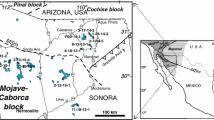Abstract
EASTERN Brazil is composed mainly of metamorphosed basement rocks1, gneisses and paragneisses (Fig. 1), which are found to increase in grade of metamorphism towards the coast, reaching granulite facies around Juiz de Fora and Lima Duarte, but which at the same time decrease in intensity of tectonic deformation. The region has been affected by at least two orogenic episodes each accompanied by characteristic igneous activity. Traces of a third earlier orogeny occur, but the first distinct evidence of movement is that of the Barbacena orogeny with its quartz dioritic type of intrusions. This is followed later by the Paraiba or Algonkian orogeny with its granitic intrusions, rich in alkali felspar2.
Similar content being viewed by others
References
Guimarães, D., Bol. Fom. Prod. Min., 88 (1951).
Ebert, H., Geol. Rundschau, 45, 471 (1956/7).
Miller, J. A., and Brown, P. E., Adv. Sci., 20, 527 (1964).
Grasty, R. L., and Miller, J. A., Nature, 207, 1146 (1965).
Cahen, L., and Snelling, N. J., The Geochronology of Equatorial Africa (North-Holland Publishing Co., Amsterdam, 1966).
The Handbook of South American Geology (edit. by Jenk, W. F.) (G.S.A. Memoir, 1956).
Author information
Authors and Affiliations
Rights and permissions
About this article
Cite this article
MONICA DIRAC, F., EBERT, H. Isotopic Ages from the Pegmatite Provinces of Eastern Brazil. Nature 215, 948–949 (1967). https://doi.org/10.1038/215948a0
Received:
Issue Date:
DOI: https://doi.org/10.1038/215948a0
- Springer Nature Limited





